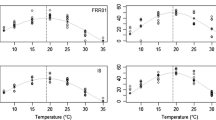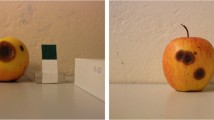Abstract
Neonectria fruit rot (NFR), an apple disease caused by the fungus Neonectria ditissima, is common in Brazilian orchards, but several aspects of its epidemiology are not well elucidated. The objectives of this study were to: i) test in vitro germination of ascospores at different temperatures and wetness periods and compare with conidia germination, ii) evaluate and compare the monocyclic components of NFR caused by conidia and ascospore infection in wounded and unwounded ripe detached ‘Gala’ apple and iii) evaluate and compare the monocyclic components of NFR caused by conidia infection in ‘Rocha’ pear fruit under different temperatures. Germination of conidia and ascospores occurred in the range of 12–28 °C. At 35 °C no germination occurred, for both ascospores and conidia, regardless of the wetness period (3–60 h). With the same wetness period, conidia germination was always higher than ascospores at any temperature. For ascospores, the optimal temperature for germination ranged from 18–21 °C, lower than the estimated for conidia, which ranged from 21 to 24 °C. In wounded detached apple fruit, the incubation period varied from 35 to 49 days after ascospore inoculation, and for conidia from 14 to 42 days. When comparing the same temperatures, mean lesion growth rate was always higher for fruits inoculated with conidia than with ascospores. Unwounded fruits inoculated in the calyx-end did not present Neonectria fruit rot symptoms. The disease on ‘Rocha’ pear fruit has shorter incubation and latent periods than those of ‘Gala’ apple and higher AUDPC at 25 °C. The fast monocycle development represents a risk if the disease spread to pear orchards but also sets pear fruit as a good option for future NFR control studies.






Similar content being viewed by others
Data Availability
The authors confirm that the data supporting the findings of this study are available within the article.
References
Alves, S. A. M., and Czermainski, A. B. C. (2015). Controle do Cancro Europeu das Pomáceas com base no novo ciclo Neonectria ditissima - macieira, nas condições do Brasil. Available at: https://ainfo.cnptia.embrapa.br/digital/bitstream/item/131885/1/Comunicado-Tecnico-178.pdf
Araujo, L., & Pinto, F. A. M. F. (2022). Neonectria ditissima spore release in apple plants and detached branches in Brazil. Journal of Plant Pathology, 104, 1283–1289.
Brown, E., & Swinburne, T. R. (1971). Benzoic acid: An antifungal compound formed in Bramley’s Seedling apple fruits following infection by Nectria galligena Bres. Physiological Plant Pathology, 1, 469–475.
Castellani, A. (1964). The “water cultivation” of pathogenic fungi. Annales Des Sociétés Belges De Médecine Tropicale, De Parasitologie, Et De Mycologie, 44, 217–219.
Dubin, H. J., & English, H. (1974). Epidemiology of European Apple Canker in California. Phytopathology, 65, 542–550.
FAOSTAT. (2019). Agriculture Organization of the United Nations Statistics Division. Economic and Social Development Department, FAOSTAT. http://www.fao.org/faostat/en/#data/QC. Accessed on 19 March 2019.
Flack, N. J., & Swinburne, T. R. (1977). Host range of Nectria galligena Bres. and the pathogenicity of some Northern Ireland isolates. Transactions of the British Mycological Society, 68, 185–192.
Gelain, J., Alves, S. A. M., Moreira, R. R., & De Mio, L. L. M. (2020). Neonectria ditissima physiological traits and susceptibility of ‘Gala’ and ‘Eva’ detached apple fruit. Tropical Plant Pathology, 45, 25–33.
Gelain, J., Pereira, W. V., & May De Mio, L. L. (2021). Detection and characterization of quiescent infections of Neonectria ditissima in Brazilian commercial apple fruit. Tropical Plant Pathology, 46, 31–36.
Ghini, R., Hamada, E., and Bettiol, W. (2011). Impactos das mudanças climáticas sobre doenças de importantes culturas no Brasil. Embrapa Meio Ambiente, Jaguariúna.
Gómez-Cortecero, A., Saville, R. J., Scheper, R. W. A., Bowen, J. K., Agripino De Medeiros, H., Kingsnorth, J., et al. (2016). Variation in host and pathogen in the Neonectria/Malus interaction; toward an understanding of the genetic basis of resistance to European canker. Frontiers in Plant Science, 7.
Hamada, N. A., Moreira, R. R., Figueiredo, J. A. G., & May De Mio, L. L. (2020). Colletotrichum acutatum complex isolated from apple flowers can cause bitter rot and Glomerella leaf spot. Bragantia, 79, 399–406.
Kim, K. S., & Beresford, R. M. (2012). Use of a climatic rule and fuzzy sets to model geographic distribution of climatic risk for European Canker of apple. Phytopathology, 102, 147–157.
Latorre, B. A., Rioja, M. E., Lillo, C., & Muñoz, M. (2002). The effect of temperature and wetness duration on infection and a warning system for European Canker (Nectria galligena) of apple in Chile. Crop Protection, 21, 285–291.
Leslie, and Summerell. (2006). Media — Recipes and Preparation. In: The Fusarium Laboratory Manual, John Wiley & Sons, Ltd, p. 3–14. Available at: https://onlinelibrary.wiley.com/doi/abs/https://doi.org/10.1002/9780470278376.ch2
Lichtemberg, P. S. F., Zeviani, W. M., Michailides, T. J., & May De Mio, L. L. (2016). Comparative in vivo and in vitro study on Monilia fructicola causing brown rot of stone fruit in Brazil and California. Tropical Plant Pathology, 41, 98–106.
MAPA-Agrofit, (2017). Sistema de Agrotóxicos Fitossanitários - Ministério da Agricultura, Pecuária e Abastecimento, Brazil. https://agrofit.agricultura.gov.br/agrofit_cons/principal_agrofit_cons. Accessed on 20 March 2017.
Maxin, P., Weber, R. W. S., Lindhard Pedersen, H., & Wiliams, M. (2012). Hot water dipping of apples to control Penicillium expansum, Neonectria galligena and Botrytis cinerea: Effects of temperature on spore germination and fruit rots. European Journal of Horticulture Science, 77, 1–9.
Oliveira, I. V. D. M., Lopes, P. R. C., and Silva-Matos, R. R. S. D. (2017). Phenological characterization of pear trees (Pyrus communis l.) ‘Princesinha’ under semiarid conditions in the northeastern Brazil. Revista Brasileira de Fruticultura. 39.
R Core Team. (2020). R: A language and environment for statistical computing. R Foundation for Statistical Computing, Vienna, Austria. URL https://www.R-project.org/
Scheper, R. W. A., Frijters, L., Fisher, B. M., & Hedderley, D. I. (2015). Effect of freezing of Neonectria ditissima inoculum on its pathogenicity. New Zealand Plant Protection., 68, 257–263.
SEAB/DERAL. (2023). Valor Bruto de Produção (Production of fruits in Parana state). Departamento de Economia Rural da Secretaria de Estado da Agricultura e do Abastecimento. https://www.agricultura.pr.gov.br/vbp
Swinburne, T. R. (1971). The infection of apples, cv. Bramley’s Seedling, by Nectria galligena. Bres. Annals of Applied Biology, 68, 253–262.
Weber, R. W. S. (2009). Betrachtung möglicher Auswirkungen des Klimawandels auf Schadpilze im Obstbau am Beispiel von Fruchtfäuleerregern an Äpfeln. Erwerbs-Obstbau, 51, 115–120.
Weber, R. W. S. (2014). Biology and control of the apple canker fungus Neonectria ditissima (syn. N. galligena) from a Northwestern European perspective. Erwerbs-Obstbau, 56, 95–107.
Weber, R. W. S., & Børve, J. (2021). Infection biology as the basis of integrated control of apple canker (Neonectria ditissima) in Northern Europe. CABI Agriculture and Bioscience, 2, 5.
Wesche, J., & Weber, R. W. S. (2023a). Are microconidia infectious principles in Neonectria ditissima? Journal of Plant Diseases and Protection., 130, 157–162.
Wesche, J., Weber, R.W.S. (2023b). Fungicide sensitivity in the European Canker fungus, Neonectria ditissima. Erwerbs-Obstbau.
Xu, X.-M., & Robinson, J. D. (2010). Effects of fruit maturity and wetness on the infection of apple fruit by Neonectria galligena: Infection of apple fruit by N. galligena. Plant Pathology, 59, 542–547.
Zeller, S. M. (1926). European Canker of Pomaceous Fruit Trees. Oregon Agriculture Experimental Station Bulletin, 222, 52.
Acknowledgements
This study was financed by the Coordenação de Aperfeiçoamento de Pessoal de Nível Superior—Brasil (CAPES), grant number 40001016031P6. The authors would like to thank Dr. Silvio Andre Meirelles Alves and Embrapa Grape and Wine for the technical support.
Funding
This study was financed by the Coordenação de Aperfeiçoamento de Pessoal de Nível Superior—Brasil (CAPES), Finance Code 001 and by the Conselho Nacional de Desenvolvimento Científico e Tecnológico (CNPq)/Brazil, Grant n. 306907/2017–8.
Author information
Authors and Affiliations
Contributions
All authors have been personally and actively involved in substantive work leading to the manuscript and will hold themselves jointly and individually responsible for its content.
Corresponding author
Ethics declarations
Conflicts of interest
On behalf of all authors, the corresponding author states that there is no conflict of interest.
Supplementary Information
Below is the link to the electronic supplementary material.
Rights and permissions
Springer Nature or its licensor (e.g. a society or other partner) holds exclusive rights to this article under a publishing agreement with the author(s) or other rightsholder(s); author self-archiving of the accepted manuscript version of this article is solely governed by the terms of such publishing agreement and applicable law.
About this article
Cite this article
Gelain, J., Zeviani, W.M. & May-De Mio, L.L. Ascospore germination and comparative monocycle of neonectria fruit rot on apple and pear. Eur J Plant Pathol 168, 743–756 (2024). https://doi.org/10.1007/s10658-023-02796-8
Accepted:
Published:
Issue Date:
DOI: https://doi.org/10.1007/s10658-023-02796-8




